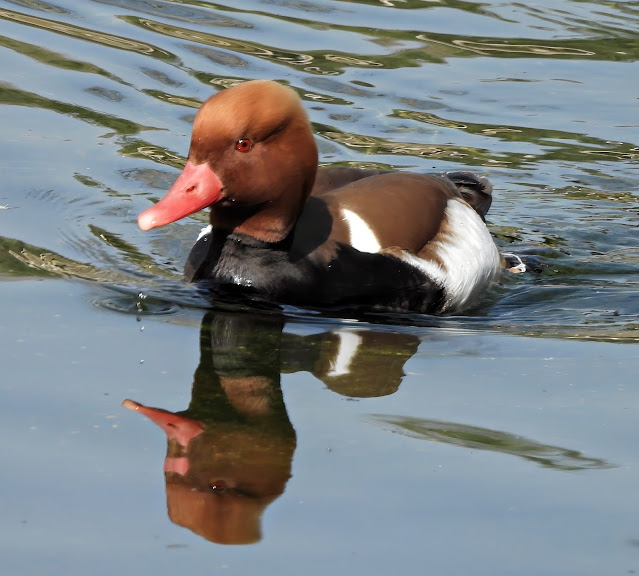The red-crested pochard (Netta rufina ) is a large diving duck. The scientific name is derived from Greek Netta "duck", and Latin rufina, "golden-red" (from rufus, "ruddy"). Its breeding habitat is lowland marshes and lakes in southern Europe and it extends from the steppe and semi-desert areas on the Black Sea to Central Asia and Mongolia, wintering in the Indian Subcontinent and Africa. It is somewhat migratory, and northern birds winter further south into north Africa.
The adult male is unmistakable. It has a rounded orange head, red bill and black breast. The flanks are white, the back brown, and the tail black. The female is mainly a pale brown, with a darker back and crown and a whitish face. Eclipse males are like females but with red bills. They are gregarious birds, forming large flocks in winter, often mixed with other diving ducks, such as common pochards. They feed mainly by diving or dabbling. They eat aquatic plants, and typically upend for food more than most diving ducks.
A wheezing veht call can be given by the male. Series of hoarse vrah-vrah-vrah calls can also be heard from females.
Red-crested pochards build nests by the lakeside among vegetation and lay 8–12 pale green eggs. The birds' status in the British Isles is much confused because there have been many escapes and deliberate releases over the years, as well as natural visitors from the continent. However, it is most likely that they are escapees that are now breeding wild and have built up a successful feral population. They are most numerous around areas of England including Gloucestershire, Oxfordshire, Northamptonshire and also spotted in Leicestershire.
The red-crested pochard is one of the species to which the Agreement on the Conservation of African-Eurasian Migratory Waterbirds (AEWA) applies.
Larger than a Pochard, the male has an orange-brown head with a red beak and pale flanks (lower sides). Females are brown with pale cheeks. In flight, they show whitish underwings. They dive, dabble and up-end for their food. There is a large population in Spain but smaller numbers in France, Netherlands and Germany. Occasional wild birds may come to the UK from the Continent. The UK breeding birds almost certainly all come from escaped birds.
The red-crested pochard is naturally found in a wide range extending from southern and central Europe across central Asia, as far west as Mongolia. Its attractive appearance has made it a popular bird in wildfowl collections in the UK. Over the years, red-crested pochards have escaped from collections and nested in the wild, leading to an established population in England.
It's possible that some of the red-crested pochards seen in the UK, particularly in southeast England, have arrived on their own from continental Europe. Over the last century, the European population has spread north into the Netherlands and Germany. They are migratory, flying between breeding grounds and wintering sites.
Red-crested pochards are usually found on freshwater lakes and pools, particularly with reedbeds. They often feed at the surface, but can also dive for food. In winter they gather in large flocks.
Red-crested pochards prefer to nest in eutrophic ponds and lakes that are bordered by emergent halophytes and beds of macrophytes. They also nest near slow-current rivers with clearings of open water or islands with shrubs and grasses. Prior to the 1980's, red-crested pochards preferred nesting near brackish water. Since then, nearly the entire breeding population has changed its habitat to freshwater marshes and reed beds, likely as a response to growing populations of yellow-legged gulls and the predators they attract.
During their molting period, red-crested pochards no longer fly. They seek out areas of open water (coastal, inland, brackish, or fresh) with an abundance of charophyte beds. In the winter months, lakes and ponds are used as daytime resting areas and the existing vegetation provides some shelter. Preferred habitats are in open spaces that are free from disturbances and contain accessible feeding sites.



%201.jpg)
%201.jpg)
%202.jpg)











%20(JUVENILE)%2010.jpg)
%20(JUVENILE)%2011.jpg)























%201.jpg)
%202.jpg)



